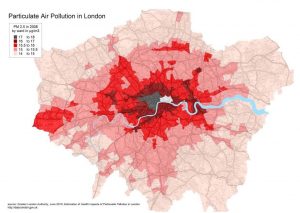The Pollution Problem – Inner-City and at Home
In the past year, the Mayor has triggered multiple alerts for outdoor air pollution in London. The scale of the city air pollution crisis was laid bare in October with new figures showing that every person in the capital is breathing air that exceeds global World health Organization Guidelines for one of the most dangerous toxic particles PM 2.5 (1). Air pollution is largely invisible, so it is hard to grasp how much damage it is doing to our health.
We are all aware that outdoor air pollution is a big problem in London, but did you know that our indoor environment is two to five times more toxic than our outdoor environment?! According to The World Health Organization 3% of the global burden of disease is due to indoor air pollution. (2)
Poor air quality has been linked to a number of different illnesses and diseases. (3) The air you breathe inside is as important as the quality of the outdoor air in the city you live.

What are the sources of indoor pollution?
1) Inadequate ventilation
2) Mould
3) Cooking & heating
4) Household cleaning products containing volatile and semivolatile compounds (4)
5) Air fresheners containing volatile organic compounds such as nitrogen dioxide.
6) Formaldehyde found in carpets & pressed wood that is used for shelving and furniture. The largest source of formaldehyde in the home is the resinous glue that holds these wood particles together.
7) Flame-retardants containing polybrominated diphenyl ethers (PBDEs) which have many negative health effects.
8) PDBEs also found in treated plastics and fabrics – they are released in dust particles and gases.
9) Building materials such as PVC containing phthalates
Nurse Fiona recommends making several small changes below to your everyday routine to reduce indoor air pollution
 1) Improve ventilation by opening windows for 5-10 minutes every day
1) Improve ventilation by opening windows for 5-10 minutes every day
2) Decorate your house or room with plants – a recent NASA study found that plants neutralise the chemicals found in furniture, household products, and decorating materials. (4)
3) Keep humidity less than 50% indoors – mould grows in damp and humid environments. Use a dehumidifier and air conditioner to keep your humidity under 50 percent. Keep the units cleaned so they aren’t a source of pollution.
4) Remove air fresheners – these release volatile organic compounds that can be harmful to your health. Replace with dried lavender or make your own by mixing essential oils with water and placing it in a spray bottle.
5) Replace cleaning products with natural alternatives such as @ecocover
6) Have your air ducts cleaned and change the filters – these filters can be a breeding ground for mould, dust and debris
7) Service your fuel burning appliances – poorly maintained natural gas heaters and stoves, furnaces, hot water heaters, space heaters, water softeners, and other fuel-burning appliances can leak carbon monoxide and nitrogen dioxide
(1) https://data.london.gov.uk/dataset/pm2-5-map-and-exposure-data
(2) https://www.who.int/mediacentre/factsheets/fs292/en/
(3) https://www.ncbi.nlm.nih.gov/pmc/articles/PMC5089137/
(4) https://www.telegraph.co.uk/gardening/how-to-grow/the-best-houseplants-to-clean-the-air-in-your-home-as-recommende/

